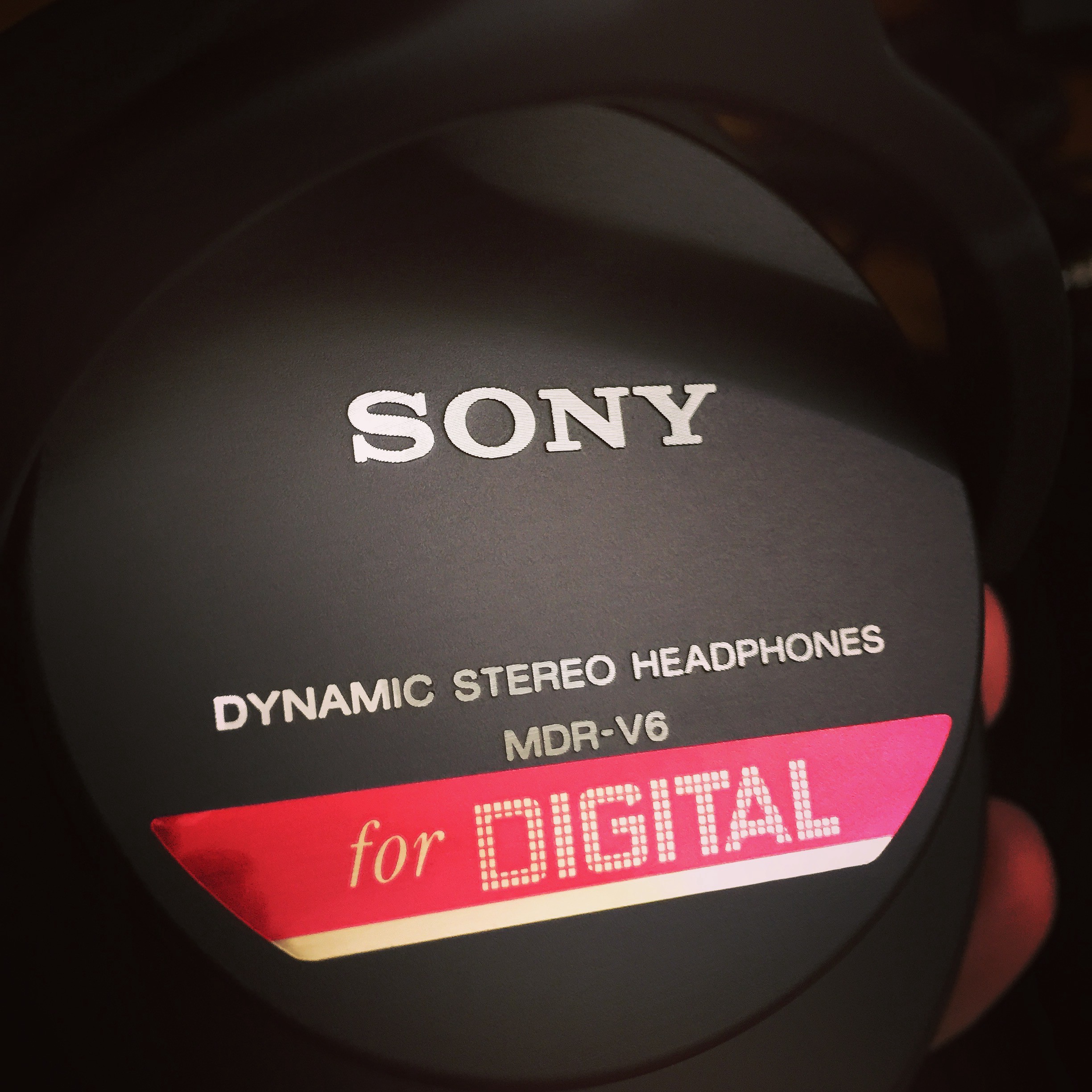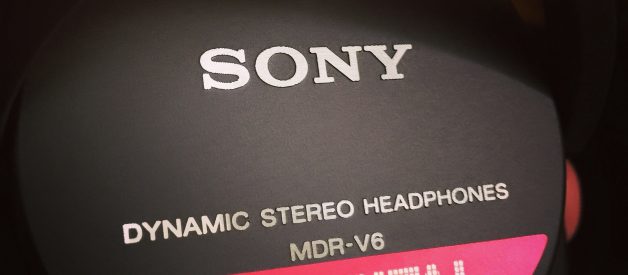In 1985, Sony released the MDR-V6, a studio monitor headphone designed for the exciting and brand-new world of Digital Audio. They pitched it as an all-in-one solution, perfect for digital production work or home CD playback. It was affordable, as high-end gear went, at about $100 bucks, and made from solid components designed to withstand field production work.
31 years later, they?re still making it.
Thank goodness for that! This $99 dollar headphone is my new favorite. It?s completely awesome.
 Make no mistake, these headphones are for DIGITAL. I love this sticker. It?s my favorite sticker ever on a thing. It?s like the 1980?s are screaming at me, in red and gold.
Make no mistake, these headphones are for DIGITAL. I love this sticker. It?s my favorite sticker ever on a thing. It?s like the 1980?s are screaming at me, in red and gold.
Chances are, you?ve probably seen this headphone, or its newer cousin the MDR-7506, at some point in your life. It?s pretty easy to spot in television productions on camera operators. They show up all the time in behind-the-scenes videos about album production, on top of singers? heads. They show up in DVD extras for animated films when voice actors record their lines. They?re ubiquitous in the production world. Once you get used to looking for them, it?s weirdly hard to stop.
Sony refreshed this headphone in the 90?s and changed the name to MDR-7506. They replaced the awesome red ?for Digital? stickers with blue stickers that say ?Professional.?
Fine. But the red stickers are still cooler. That?s just a fact. They changed the plug material from nickel plating to gold plating, which makes the 7506 slightly easier to amp thanks to the conductivity of gold. They updated the magnets in both models to use Neodymium instead of Samarium-Cobalt.
But other than all that, this headphone has been the same since 1985.
Some folks online debate endlessly about whether or not the 7506 and V6 sound different. From everything I?ve read, and from studying countless measurements of both models, they?re 99 percent identical. The 7506 might be a tiny bit brighter in the top end, but no amount of internet passion can convince me that there?s a noticeable difference. So when you go to buy, it?s down to preference for plug and sticker color. And which one is on sale right now.
The V6 has an easier name to say, and cooler stickers. Just sayin?.
My own history with this headphone before this week is limited. They started producing these when I was one year old. I?ve encountered a few pairs of 7506?s over the years, first in a production studio, and later in college. About 13 years ago I worked in the equipment checkout lab at my college, and we had a pair kicking around down there. I remember them being surprisingly comfy, and adequate for video work. I wish I had paid more attention.
Over the intervening years, as this model has continued to sell and rack up excellent reviews, it sat in the back of my mind as a ?someday? headphone.
Then, my local Fry?s electronics bought a bunch of V6?s for some reason.
This meant I could get them in 45 minutes and not have to pay shipping.
I?m glad I finally bit on these, because they?re my favorite headphones now. Period.
Audio is subjective, as is headphone taste, but come, let me tell you why these are amazing. First, let me get some quibbles out of the way.
QUIBBLES
Non-removable Cable: The cable is permanently attached to the V6. It?s a 1m coiled cable that can stretch to 3m. It has an all-metal nickel-plated plug and excellent strain relief. Most headphones these days use detachable cables. Audio-Technica even updated the M50 to include a detachable cord. Sony has not done that. It might really bother you if you?re used to other modern headphones.
Style: Okay. I love the style of these headphones. But I?m a weirdo, who would probably be considered an old guy in the internet reviews world. Look at this photo!
 LOOK AT THIS 80?S BUSINESS
LOOK AT THIS 80?S BUSINESS
The V6 have the words ?STUDIO MONITOR? printed on top of them in silvery letting for no good or readily apparent reason. Many people will look at this and go ?ew why.?
But if you?re like me, you see this and go ?Oh yes. This is how it should be.?
The whole style of this headphone is like this, because again? it hasn?t changed since 1985. And it was never meant to look cool in the first place. It was made as a perfect tool ?for DIGITAL? audio. Many folks will totally hate the aesthetic, and I can?t even be mad about that. But I love how they look.
Quibbles over!
POSITIVES
Sound: In the grand tradition of online headphone reviews, I have written a million words and I?m only now getting to the sound part.
For me, they sound perfect. Natural. Balanced, yet still fun. Like I?m listening to real instruments. They blew me away from first listen, even though I?ve heard a lot of different pairs.
They?ve supplanted every other headphone I?ve ever used. They?ve replaced a good chunk of my small collection. And I?m not going back.
Sound quality is largely subjective. Some folks out there think that this headphone is a little too trebel-y for their tastes. If you?re used to warmer, bass-tilted sound signatures, like what comes out of a Beats or Bose headphone, or even most modern Sony headphones, you might share this complaint.
It still has scads of bass when needed, thanks to its clever design (more on that below!). The bass is tight and punchy, without bleeding too much into the other sounds. The mids and highs shoot out over the top of the bass, as they should. The highs aren?t quite as grainy and sparkly as those on the M50X, but they?re still crisp and satisfying. The V6 is a fast, sharp, detailed headphone.
Basically, once I started listening to all my favorite test music tracks, I could immediately see why Sony pitched these as perfect for digital audio. They still work well 31 years later. There?s a double-edged sword to this colder, more clinical style of reproduction however: if you listen to badly recorded or compressed material, you?ll notice it.
But the overall clarity is worth it.
The V6 provides a detailed, crisp, sharp sound signature with chest thumping bass when required. The soundstage is rich, dynamic, and nicely-separated. If you turn them up too high, the treble may irritate you, and if you like a warm/creamier sound, perhaps look elsewhere. But for me, I?ve found a new favorite.
Design/Comfort/Isolation: The V6 has one of the cooler designs I?ve seen in a headphone ear cup.
Most non- earbud headphones fall into two different categories: on-ear and over-ear.
On-Ear, or Supra Aural Headphones, sit on your ears, forming a seal with the material of your ear itself. The Beats Solo line is the most popular line of on-ear headphones right now. On-ear headphones produce good bass and decent isolation, but they get uncomfortable after prolonged use.
Over-Ear, or Circumaural Headphones, have large comfy cushions that fully surround your ear. They create a seal with the side of your head, using the skin around your ear. They provide better soundstage, as sound can bounce off the surface of your ear the way it might in the real world or with speakers.
The seal a headphone makes with your head is important for both bass and isolation. If the seal is broken in any way, these suffer.
I have a large head and I wear glasses, which can make achieving a good seal tough, especially with over-ear headphones. The arm of my glasses cuts into the pad, often preventing a proper seal. I get much less bass and isolation as a result. It doesn?t always make headphones unlistenable, but it can significantly impact their audio quality for me personally, and for other glasses-wearers.
On-ear headphones seal well on my head, but they can pinch. The pressure on my ears eventually pushes into my glasses, causing pain.
The Sony MDR-V6 has combined the best of both worlds, with no drawbacks. Sony devotes a paragraph of the manual to their interesting design.
Basically, the V6 is a hybrid of on-ear and over-ear. The actual headphones are on-ear, but the pads are over-ear. The seal is created between your ear and the center of the pad, and the outside cushy part of the pad is just there to provide additional isolation and comfort. So, breaking the seal with glasses doesn?t actually impact the bass-level, and has minimal effect on isolation.
This is brilliant! The result is a super comfy headphone that still provides punchy sound, even when I wear my glasses. The clamping force is perfect. You could wear these for hours, no problem. Isolation is very good, though not quite market-leading or on the level of active noise-cancelling models. I test isolation in a loud coffee shop, and these performed really well.
Everyone should steal this concept. They?ve had 31 years to do so. Hmm. Sony should make all their over-ear headphones this way?but they don?t for some reason.
I bet the person who wrote that paragraph in the manual is bummed to this day.
Extra Notes: In spite of having a moderate resistance of 64 ohms and a nickel-plated plug, these are still quite sensitive and pretty easy to drive, no special amp needed. Make sure you start your music with the sound turned down, as they can get very loud even on a phone.
They come with a solid leatherette drawstring bag, with a canvas interior. The packaging is fun, presenting the headphones on a bed of red cloth. It?s a little harder to get them extracted from the packaging than I would like. A quarter-inch adapter is included for the plug. The headphones collapse inward, and the manual includes a diagram showing you how to not pinch your fingers while performing this. The headband is nice and wider than average, with that cool lettering shown above and adequate padding for long sessions.
If you find the 7506 for cheaper and you hate awesome red stickers, that?s a great alternative.
Final Thoughts
This is my favorite headphone. It sounds great for any use case, from music to gaming to production, and it?s only $99 bucks. Often it goes for less! It was designed when I was an infant. It comes with cool red stickers on it. It doesn?t have the extras of other popular headphones in this price range like the HyperX Cloud II or the M50X, nor the styling of the MDR-100 AAP, but I prefer its sound to all of those. Heck, I prefer its sound to many headphones I?ve heard that cost three times as much.
If you can deal with the old-school look and feel, these headphones will reward you with textured, crisp, accurate sound that you?ll notice and enjoy immediately. If you need things like control buttons, bluetooth, a detachable cable, colors, or modern styling?well, I don?t blame you, because that represents a lot of people.
But maybe don?t miss out on this comfy, great-sounding headphone just because its design is old.
If I could go back, I?d just start my headphone journey right here. These are ?for DIGITAL? afterall. I should have listened to the sticker. The sticker knows all.
 These fit my head with plenty of room to spare, so you?ll have no trouble!
These fit my head with plenty of room to spare, so you?ll have no trouble!


